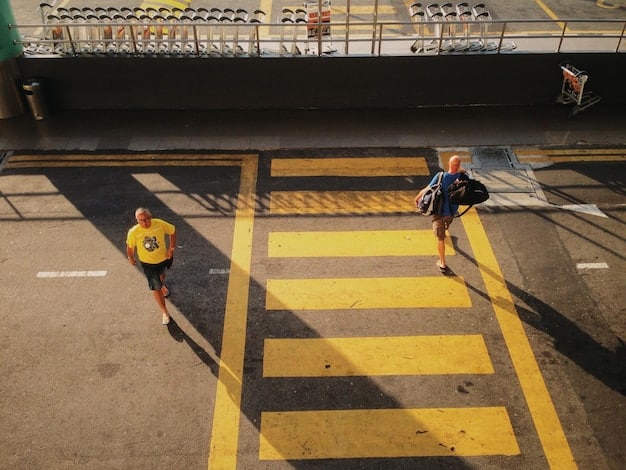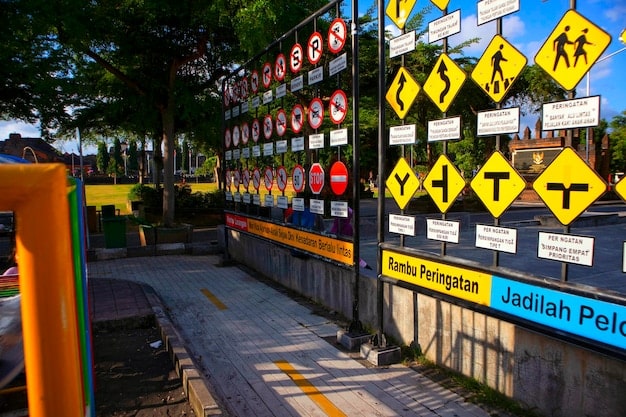School Zone Construction: Safety Tips & Navigating Challenges

School zone construction presents unique safety challenges for students, parents, and drivers; understanding these issues and adhering to safety guidelines is crucial for preventing accidents and ensuring the well-being of everyone in the community.
Navigating areas undergoing school zone construction requires extra vigilance and understanding of potential hazards. This article will provide essential tips and guidelines to help keep everyone safe during these periods of infrastructure improvement.
Understanding the Scope of School Zone Construction
School zone construction projects are undertaken for various reasons, ranging from infrastructure upgrades to building new facilities. Understanding the scope of these projects and their potential impact on traffic and pedestrian safety is crucial for developing effective safety strategies.
Types of Construction Projects
Construction projects in school zones can vary widely, including road improvements, building expansions, and utility upgrades. Each type of project presents unique challenges and requires specific safety measures.
- Road Improvements: Resurfacing, widening, or adding traffic signals can disrupt traffic patterns and pedestrian routes.
- Building Expansions: Constructing new classrooms or facilities often involves heavy machinery and increased truck traffic.
- Utility Upgrades: Installing or repairing underground utilities can create temporary hazards and require detours.
Impact on Traffic and Pedestrians
Construction zones can significantly impact traffic flow and pedestrian safety, leading to congestion, delays, and increased risk of accidents. Awareness of these potential impacts is essential for planning safe routes and adjusting travel habits.

Essential Safety Tips for Drivers in School Zones
Drivers play a critical role in ensuring safety in school zones undergoing construction. Adhering to traffic laws, reducing speed, and staying alert are paramount to preventing accidents and protecting students and pedestrians.
Obey Traffic Laws and Signage
Traffic laws and signage are designed to regulate traffic flow and ensure safety in school zones. Drivers must obey speed limits, stop for pedestrians in crosswalks, and follow instructions from crossing guards.
Ignoring traffic laws can have severe consequences, including fines, penalties, and, most importantly, endangering lives.
Reduce Speed and Increase Following Distance
Reducing speed in school zones is essential, especially during construction. Increased following distance provides additional reaction time in case of unexpected stops or pedestrian crossings.
- Reduce Speed: Lower speed limits are often posted in school zones during construction.
- Increase Following Distance: Maintain a safe distance between your vehicle and the one ahead.
- Stay Alert: Be prepared to stop quickly if necessary.
Avoid Distractions
Distracted driving is a major cause of accidents in school zones. Drivers should avoid using cell phones, eating, or engaging in any activity that takes their attention away from the road.
Focusing solely on driving ensures that drivers can react promptly to potential hazards and protect pedestrians.
Safety Guidelines for Students and Pedestrians
Students and pedestrians must also take precautions to ensure their safety in school zones undergoing construction. Following designated routes, being aware of their surroundings, and avoiding distractions are crucial steps.
Use Designated Crosswalks and Routes
Designated crosswalks and routes are established to provide safe passage for students and pedestrians. These routes are often monitored by crossing guards and offer the safest way to navigate construction zones.
Deviating from designated routes can expose pedestrians to increased risks and hazards.
Be Aware of Surroundings
Staying aware of surroundings is essential for pedestrians in construction zones. Looking both ways before crossing the street, paying attention to traffic signals, and avoiding distractions can help prevent accidents.

- Look Both Ways: Before crossing any street, look left, right, and left again to ensure no vehicles are approaching.
- Pay Attention to Signals: Obey traffic signals and pedestrian crossing signals.
- Avoid Distractions: Put away cell phones and other devices to focus on your surroundings.
Wear Reflective Clothing
Wearing reflective clothing increases visibility, especially during low-light conditions or inclement weather. Reflective gear helps drivers see pedestrians more easily, reducing the risk of accidents.
Brightly colored clothing can also improve visibility during daylight hours.
Working with Construction Crews and School Authorities
Effective communication and collaboration between construction crews, school authorities, and the community are essential for maintaining safety in school zones. Clear communication channels, regular updates, and community involvement can help address concerns and mitigate potential risks.
Establish Clear Communication Channels
Establishing clear communication channels ensures that information about construction activities, safety measures, and potential disruptions is disseminated effectively. Regular updates and open dialogue can help address concerns and keep everyone informed.
Communication channels may include email newsletters, school websites, and community meetings.
Regular Updates and Community Involvement
Providing regular updates about construction progress, safety protocols, and any changes to traffic patterns or pedestrian routes is crucial for maintaining community trust and cooperation. Involving the community in safety planning can also help identify potential risks and develop effective solutions.
- Construction Updates: Regularly update the community on the progress of the construction project.
- Safety Protocols: Communicate safety protocols to students, parents, and drivers.
- Community Meetings: Hold community meetings to address concerns and gather feedback.
Addressing Concerns and Resolving Issues
Promptly addressing concerns and resolving issues that arise during construction is essential for maintaining a safe and positive environment. Establishing a clear process for reporting concerns and providing timely responses can help prevent minor issues from escalating into major problems.
Long-Term Planning and Safety Measures
Implementing long-term planning and safety measures is essential for creating a sustainable and safe environment in school zones undergoing construction. Permanent infrastructure improvements, ongoing safety education, and continuous monitoring can help mitigate risks and protect students and pedestrians.
Permanent Infrastructure Improvements
Permanent infrastructure improvements, such as wider sidewalks, improved crosswalks, and dedicated bike lanes, can enhance safety and accessibility in school zones. These improvements can also help reduce congestion and improve traffic flow.
Strategic planning and investment in infrastructure are essential for creating a safe and sustainable environment.
Ongoing Safety Education
Providing ongoing safety education to students, parents, and drivers reinforces safe behaviors and promotes awareness of potential hazards. Educational programs can cover topics such as pedestrian safety, traffic laws, and construction zone safety.
- Pedestrian Safety: Teach students how to safely cross streets and navigate construction zones.
- Traffic Laws: Educate drivers about traffic laws and the importance of obeying speed limits and signage.
- Construction Zone Safety: Provide information about the specific hazards present in construction zones.
Continuous Monitoring and Evaluation
Continuously monitoring and evaluating the effectiveness of safety measures is essential for identifying areas for improvement and ensuring that strategies are adapted to changing conditions. Regular assessments and feedback from the community can help refine safety protocols and enhance overall safety.
The Role of Technology in Enhancing Safety
Technology plays an increasingly important role in enhancing safety in school zones under construction. Smart traffic management systems, real-time monitoring, and mobile apps can provide valuable tools for improving safety and communication.
Smart Traffic Management Systems
Smart traffic management systems use sensors and data analytics to optimize traffic flow and reduce congestion. These systems can adjust traffic signals in real-time based on traffic conditions, helping to alleviate congestion and improve safety.
Adaptive traffic signals can respond to changes in traffic patterns, reducing delays and improving overall efficiency.
Real-Time Monitoring and Alerts
Real-time monitoring and alerts can provide valuable information about traffic conditions, construction activities, and potential hazards. Sensors and cameras can track traffic flow, pedestrian movements, and construction progress, providing real-time data to authorities and the public.
- Traffic Monitoring: Track traffic flow and identify congestion hotspots.
- Pedestrian Detection: Detect pedestrians in crosswalks and alert drivers.
- Construction Alerts: Provide real-time updates about construction activities and potential disruptions.
Mobile Apps and Communication Tools
Mobile apps and communication tools can provide a convenient way for students, parents, and drivers to access important information about school zone safety. Apps can provide real-time traffic updates, construction alerts, and safety tips, helping everyone stay informed and safe.
Mobile apps can also facilitate communication between school authorities, construction crews, and the community.
| Key Action | Brief Description |
|---|---|
| 🚧 Obey Signs | Follow all posted traffic signs and directions in construction areas. |
| 🚶 Use Crosswalks | Always cross streets at designated crosswalks, looking both ways. |
| 📱 Avoid Distractions | Refrain from using cell phones or other devices while walking or driving. |
| 🚗 Reduce Speed | Lower your speed in school zones to increase reaction time. |
Frequently Asked Questions (FAQs)
▼
Construction in school zones is often necessary to improve infrastructure, enhance safety, or expand facilities to accommodate growing student populations. These projects aim to create a better learning environment.
▼
Safety concerns can be reported to the school administration, the construction project manager, or local authorities. Clear communication channels are typically established for addressing such issues promptly.
▼
Protective measures include designated walkways, crossing guards, reduced speed limits, and physical barriers to separate construction activities from pedestrian areas, ensuring student safety.
▼
Yes, alternative routes are often provided to help drivers and pedestrians bypass construction zones. These routes are usually marked with clear signage to guide traffic safely.
▼
Updates on construction progress and safety measures are typically provided regularly through school newsletters, websites, and community meetings to keep everyone informed and address any concerns.
Conclusion
Navigating school zone construction requires a collaborative effort from drivers, students, pedestrians, construction crews, and school authorities. By following safety guidelines, staying informed, and communicating effectively, we can ensure the safety and well-being of everyone in the community during these periods of infrastructure improvement.





